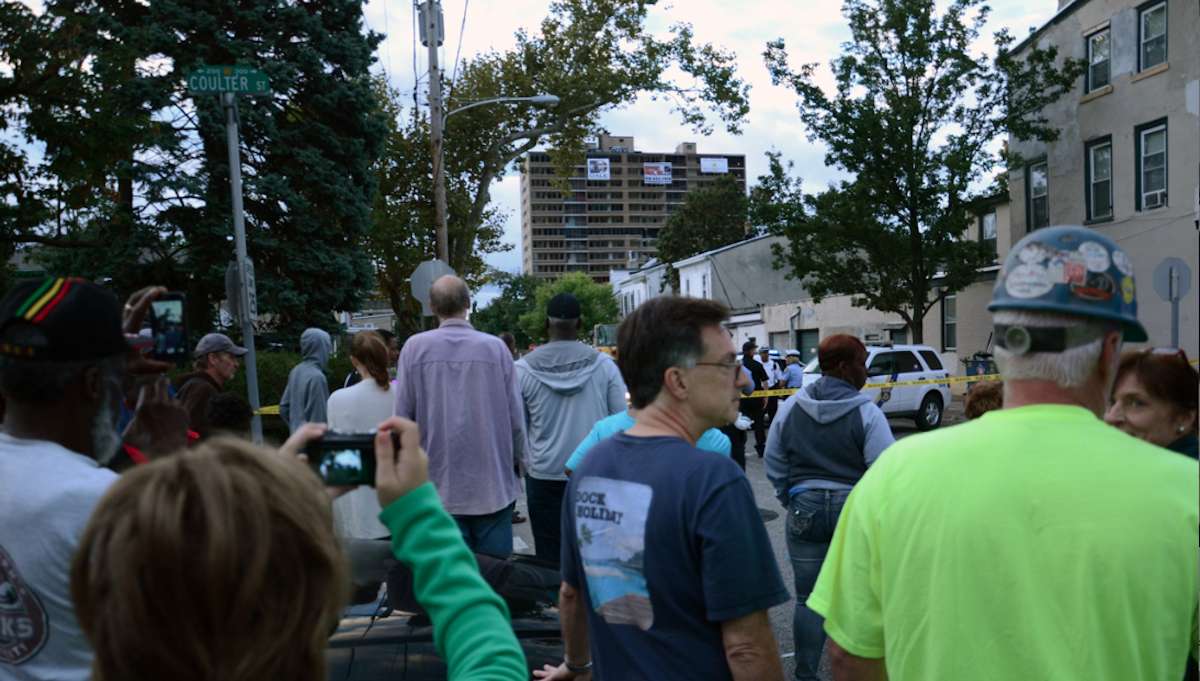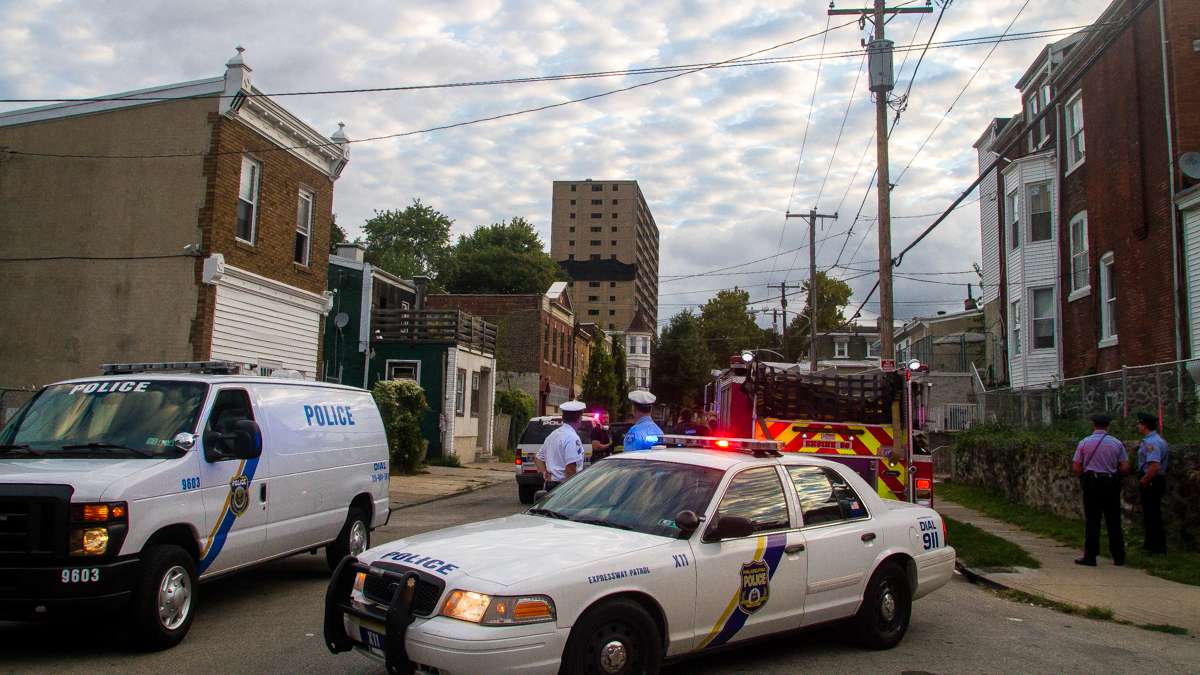Queen Lane Apartments tower reduced to rubble after Saturday morning implosion [video and photo gallery]
-

-

-

-

-

-

-

-

-

-

-

-

-

-

-

-

-

-

-

-

-

-

-

-

-

-

-

-

-

-

-

-

-

-

-

-

City Councilwoman Cindy Bass applauds after pushing the 'detonator' that sent the Queen Lane Apartment demolition in motion on Saturday. (Bas Slabbers/for NewsWorks)
-

-

-

-

-

-

-

-

-

-

-

-

-

-

-

-

At 5:45 a.m. Saturday, a team of police officers and Philadelphia Housing Authority representatives stood outside a door in the 300 block of W. Penn St.
Their mission: Get what was believed to be the last holdouts inside a home in the Queen Lane Apartments-implosion evacuation zone away from the property directly across the street from the site.
“She has to come out now,” said a police lieutenant. “Go through and make sure it’s clear.”
Seconds later, Wanda Elam exited her front door, making sure she put her earrings on before heading to the community ceremony a block away.
“It’s sad to see in a way, but we’re grateful that this will help people in need of housing,” said Elam, nonplussed by the early wake-up call since she works the night shift anyway. “We got to keep up with the times.”
The implosion
The tower that loomed outside Elam’s front windows for decades would stand for another 75 minutes, until the long-awaited implosion became a Germantown reality at 7:15 a.m. Saturday.
Some residents, like Michael Williams of West Queen Lane, left the area beforehand. In Williams’ case, he packed a waffle iron to walk down to his son’s in East Falls, where he planned stay for a few hours after breakfast.
But many others packed corners just outside the evacuation zone, some with dust masks over the noses and mouths, most with smart-phone cameras trained on the site, to witness and record a moment of neighborhood history.
Fifteen seconds after a series of explosions echoed through the air — NewsWorks readers reported hearing it as far away as Roxborough, Mt. Airy, East Falls and Allegheny West — the 59-year-old apartment tower was reduced to a pile of rubble twice the height of a two-story home across West Penn Street from the site.
Clouds of dust billowed west along Queen Lane, sending observers off toward the cleaner air of home. Vehicles parked near W. Penn and Morris sts. were in dire need of a car wash.
Demolition contractors quickly broke out brooms and operated sweepers, cleaning up debris that fell onto West Queen Lane and Pulaski Ave. Insulation foam blew into the chain-link fence on the property’s Penn Street side.
Among the reactions of people emerging from homes just outside the evacuation zone were “It’s like the apocalypse!,” “It feels like a funeral for an old friend” and “That was crazy.”
“I totally forgot about it. The explosions woke me up,” said Keith Hartwig who walked over to the site afterwards to take a look at what remained. “There were just clouds of dust everywhere I could see.”
One neighbor grabbed a commemorative cinderblock to use as a doorstop and said he worried about rats scurrying out of that rubble pile.
The PHA has imploded 22 buildings at seven sites over the years. The 16-story high-rise built in the 1950s on West Queen Lane was the eighth site. Eight high-rise sites containing 16 buildings with 1,880 residential units still stand.
A years-long issue
The PHA issued a 90-day notice to the residents of the Queen Lane Apartments back on Aug. 19, 2011, and the relocation of 116 families began a week later.
What ensued was years of community debate that left PHA officials considering the option of revamping the tower itself instead of imploding it.
Replacing the tower eventually will be 55 new rental apartments ringing a roughly two-acre green space, once a Potter’s Field, an 18th century burial ground for “all strangers, Negroes, and Mulattoes [who] die in any part of Germantown forever.”
Construction is expected to last a year.
The Potter’s Field ceremony
Before the implosion, a pair of ceremonies was held at a tent a block away from the site.
Those events started off with an African libation ceremony in homage to those buried at the site’s Potter’s Field. (After a series of disputes between neighbors and the PHA, plans to rebuild on the land include an open green space commemorating those buried there.)
Led by Ron McCoy of the Avenging the Ancestors Coalition, a group known for their work in bringing about a slavery memorial on 6th and Market streets, the libation ceremony gave “respect to our ancestor’s spirits.”
“We ask them to come among us and honor the work we are doing,” he said. “In this case, the work is honoring our ancestors that were buried here. They are no longer forgotten.”
McCoy “gave libations” to those buried at the site, well-known African and African-American figures and the deceased family members of those present. He concluded the ceremony by noting “we don’t know who is here, but they are ours.”
Michael Coard, a founding member of ATAC, said he knew nothing about the Potter’s Field until Lisa Hopkins of Northwest Neighbors of Germantown community group approached him.
“That’s one of the worst parts of this — that nobody thought it was important enough to talk about it. Fortunately, we are talking about it today,” he said.
Of the ceremony, Coard noted, “We see the end of the desecration of our ancestors and beginning of the consecration of our ancestors.”
Added Hopkins at the ceremony, “There’s been a divide in the past. As that building falls down, everything was inside of it will come down with it.”
From the PHA and City Hall
The West Coulter Street tent also hosted an event in which officials and residents celebrated the end of what proved to be a long, complicated process.
Michael Johns, the PHA’s deputy executive director of capital projects and development, got things started.
“This is a wonderful day,” he said. “How long have we’ve been waiting?”
“Too long,” neighbors responded.
PHA CEO Kelvin Jeremiah then asked “Are you ready to make history?”
“Yes!” came the emphatic responsive from many attendees.
Jeremiah then noted that, “We are demolishing it to help transform the community, to build units that are more consistent with what remains in the community. We’re building a new development, but more than that, we’re actually building neighborhoods of choice where families can thrive.”
For her part, Eighth District City Councilwoman Cindy Bass offered context.
“This is an important moment in the history of Germantown,” she said. “This shouldn’t just be a blip on the radar of Germantown.
“I have great hopes and expectations in terms of the job that PHA is going to do with the new townhouses. I think it’s going to be a wonderful asset to the community and we’re going to continue to grow closer together, and I’m looking forward to that.
“There’s progress happening in Germantown. Don’t let anybody tell you anything different. And this is progress. This is moving us forward.”
The “comfort zone” scene
It’s 6 a.m. outside the Cook-Wissahickon Elementary School on E. Salaignac Street in Manayunk where residents of the implosion’s evacuation zone were provided a “comfort zone” early Saturday morning.
PHA minibuses shuttled residents here throughout the morning and staffers escorted them in through a rear entrance.
As the last of the riders are escorted into the school cafeteria, a van pulls into the driveway. Caterers began rolling trays stacked with food into the building.
Inside the cafeteria, as the staff sets out beverages and snacks on a long serving table, around 25 people, young and old, gathered around a handful of tables. They engaged in hushed conversations.
On the far side of the room, two police officers stand at the ready. An EMS team is on hand as well.
As an audio/video crew unloads a large flat-screen television and carries it into the building, a woman exited the cafeteria past the ambulance and walks her dog around the perimeter of the parking lot.
Two utility vans arrived and more staffers wearing “Queen Lane Implosion” laminates around their necks make their way into the building.
Post-implosion clean-up efforts
After the post-implosion dust started to settle, residents were searching the sidewalk for bricks and turned to cleaning crews for help.
“Hey!” shouted one resident. “Grab a brick for me and my mom. I want to remember this!”
The destruction of the Queen Lane Apartments marked a historical moment for those who have lived in the neighborhood for decades. The change was already sinking in.
Beatrice Dingle, of the 5200 block of Pulaski Ave., said she remembers moving into her current row home 40 years ago in the shadow of the tower.
She was surprised to see no damage or dust on her property.
However, south of the implosion site, dust heavily lined front steps, trees and lawns.
One house near the corner of Priscilla Street and West Queen Lane had two windows cracked and shattered, something the resident was told would be fixed by the city in the coming weeks.
Officials from various city departments toured the site with hardhats and face masks to assess any cases of collateral damage that, besides the windows, didn’t appear to be numerous.
Soon after the building collapsed, the cleaning crews sectioned off the rubble with a fence, collected any loose debris and washed the streets with tanker trucks.
Outside of the area immediately surrounding the rubble, there was no visible dust, but workers hanged air sampling pumps from street signs and walked the sidewalks with sampling tubes to gauge whether it was healthy enough for residents to start moving back into their homes.
For full coverage of the saga, see the “related article” links under this story.
This story was reported by Brian Hickey, Neema Roshania, Marcus McCarthy, Aaron Moselle and Dan Pasquarello. The video was shot by Brad Larrison and Bas Slabbers.
WHYY is your source for fact-based, in-depth journalism and information. As a nonprofit organization, we rely on financial support from readers like you. Please give today.

